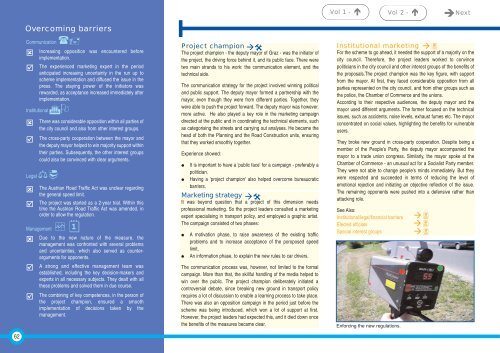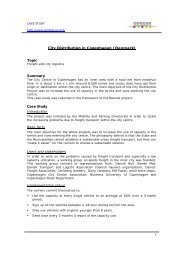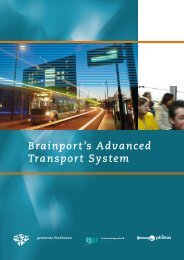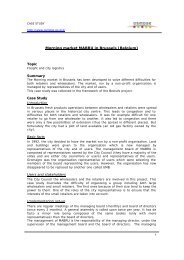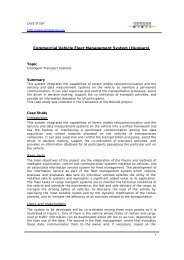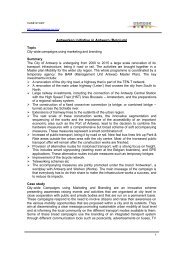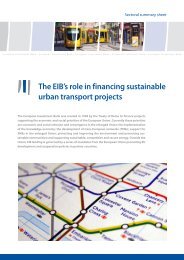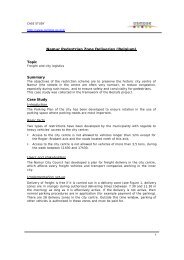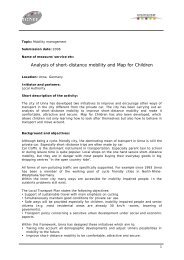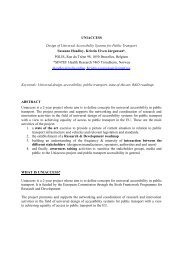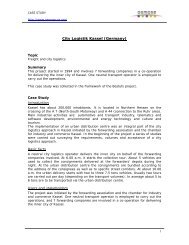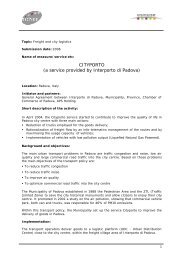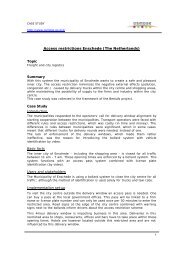Successful transport decision-making - Osmose
Successful transport decision-making - Osmose
Successful transport decision-making - Osmose
Create successful ePaper yourself
Turn your PDF publications into a flip-book with our unique Google optimized e-Paper software.
62<br />
Overcoming barriers<br />
Communication <br />
<br />
Increasing opposition was encountered before<br />
implementation.<br />
<br />
The experienced marketing expert in the period<br />
anticipated increasing uncertainty in the run up to<br />
scheme implementation and diffused the issue in the<br />
press. The staying power of the initiators was<br />
rewarded, as acceptance increased immediately after<br />
implementation.<br />
Institutional <br />
<br />
<br />
There was considerable opposition within all parties of<br />
the city council and also from other interest groups.<br />
The cross-party cooperation between the mayor and<br />
the deputy mayor helped to win majority support within<br />
their parties. Subsequently, the other interest groups<br />
could also be convinced with clear arguments.<br />
Legal <br />
<br />
The Austrian Road Traffic Act was unclear regarding<br />
the general speed limit.<br />
<br />
The project was started as a 2-year trial. Within this<br />
time the Austrian Road Traffic Act was amended, in<br />
order to allow the regulation.<br />
Management <br />
<br />
Due to the new nature of the measure, the<br />
management was confronted with several problems<br />
and uncertainties, which also served as counterarguments<br />
for opponents.<br />
<br />
A strong and effective management team was<br />
established, including the key <strong>decision</strong>-makers and<br />
experts in all necessary subjects. They dealt with all<br />
these problems and solved them in due course.<br />
<br />
The combining of key competences, in the person of<br />
the project champion, ensured a smooth<br />
implementation of <strong>decision</strong>s taken by the<br />
management.<br />
Project champion<br />
The project champion - the deputy mayor of Graz - was the initiator of<br />
the project, the driving force behind it, and its public face. There were<br />
two main strands to his work: the communication element, and the<br />
technical side.<br />
The communication strategy for the project involved winning political<br />
and public support. The deputy mayor formed a partnership with the<br />
mayor, even though they were from different parties. Together, they<br />
were able to push the project forward. The deputy mayor was however,<br />
more active. He also played a key role in the marketing campaign<br />
directed at the public and in coordinating the technical elements, such<br />
as categorising the streets and carrying out analyses. He became the<br />
head of both the Planning and the Road Construction units, ensuring<br />
that they worked smoothly together.<br />
Experience showed:<br />
It is important to have a 'public face' for a campaign - preferably a<br />
politician.<br />
Having a 'project champion' also helped overcome bureaucratic<br />
barriers.<br />
Marketing strategy <br />
It was beyond question that a project of this dimension needs<br />
professional marketing. So the project leaders consulted a marketing<br />
expert specialising in <strong>transport</strong> policy, and employed a graphic artist.<br />
The campaign consisted of two phases:<br />
<br />
<br />
<br />
A motivation phase, to raise awareness of the existing traffic<br />
problems and to increase acceptance of the poroposed speed<br />
limit,<br />
An information phase, to explain the new rules to car drivers.<br />
The communication process was, however, not limited to the formal<br />
campaign. More than that, the skillful handling of the media helped to<br />
win over the public. The project champion deliberately initiated a<br />
controversial debate, since breaking new ground in <strong>transport</strong> policy<br />
requires a lot of discussion to enable a learning process to take place.<br />
There was also an opposition campaign in the period just before the<br />
scheme was being introduced, which won a lot of support at first.<br />
However, the project leaders had expected this, and it died down once<br />
the benefits of the measures became clear.<br />
Vol 1 - <br />
Institutional marketing<br />
For the scheme to go ahead, it needed the support of a majority on the<br />
city council. Therefore, the project leaders worked to convince<br />
politicians in the city council and other interest groups of the benefits of<br />
the proposals.The project champion was the key figure, with support<br />
from the mayor. At first, they faced considerable opposition from all<br />
parties represented on the city council, and from other groups such as<br />
the police, the Chamber of Commerce and the unions.<br />
According to their respective audiences, the deputy mayor and the<br />
mayor used different arguments. The former focused on the technical<br />
issues, such as accidents, noise levels, exhaust fumes etc. The mayor<br />
concentrated on social values, highlighting the benefits for vulnerable<br />
users.<br />
They broke new ground in cross-party cooperation. Despite being a<br />
member of the People's Party, the deputy mayor accompanied the<br />
mayor to a trade union congress. Similarly, the mayor spoke at the<br />
Chamber of Commerce - an unusual act for a Socialist Party member.<br />
They were not able to change people’s minds immediately. But they<br />
were respected and succeeded in terms of reducing the level of<br />
emotional rejection and initiating an objective reflection of the issue.<br />
The remaining opponents were pushed into a defensive rather than<br />
attacking role.<br />
See Also:<br />
Institutional/legal/financial barriers<br />
Elected officials<br />
Special interest groups<br />
Enforcing the new regulations.<br />
Vol 2 - <br />
<br />
<br />
<br />
<br />
Next


